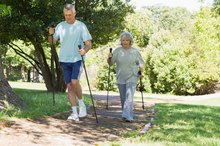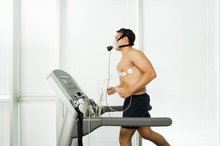Exercises for Congestive Heart Failure Patients
Heart failure refers to the condition of your heart when it does not pump as well as it should, according to the American Heart Association. Because your cells and tissues cannot get enough blood, many everyday activities become difficult. Although heart failure is a serious condition, making healthy lifestyle changes, including participating in regular exercise, can help you manage your condition.
Considerations
Follow your doctor’s instructions exactly when starting an exercise program. Exercise is safe even if you have heart disease, but always be careful. Because your condition may differ from another individual's, your specific exercise plan should be developed by your doctor and trained professionals familiar with your condition. Failure to follow your doctor’s instructions may cause serious injuries.
- Follow your doctor’s instructions exactly when starting an exercise program.
- Because your condition may differ from another individual's, your specific exercise plan should be developed by your doctor and trained professionals familiar with your condition.
Aerobic Exercise
Exercise Therapy for Cauda Equina Syndrome
Learn More
The American Heart Association reports that aerobic exercise is safe and beneficial for patients with heart failure. Walking on a treadmill and cycling on a stationary bike are often recommended for congestive heart failure patients. Aerobic exercise can help you improve the efficiency of your heart and improve blood flow, which allows your cells and tissues to receive the oxygen and other nutrients they need to function properly.
Strength Training
Participating in strength-training exercises is also possible if you suffer from heart failure, according to the American College of Sports Medicine. Use resistance bands or light free weights and proper technique to prevent injuries. Using controlled movements, maintaining a regular breathing pattern and avoiding straining are recommended when strength training. The ACSM also warns you to stop exercising if you feel dizzy, experience an unusual shortness of breath or feel chest pain.
- Participating in strength-training exercises is also possible if you suffer from heart failure, according to the American College of Sports Medicine.
- Using controlled movements, maintaining a regular breathing pattern and avoiding straining are recommended when strength training.
Recommendations
The Best Exercise If You Have Arotic Heart Disease
Learn More
Although your specific exercise program should be developed by your doctor, general exercise guidelines for patients with congestive heart failure include 20 to 30 minutes of aerobic exercise performed three to five times each week. The American Heart Association also recommends gradually warming up and cooling down to avoid strain on your heart. You should participate in strength training exercises for your major muscle groups at least two times each week. Gradually increase the resistance as your strength increases.
- Although your specific exercise program should be developed by your doctor, general exercise guidelines for patients with congestive heart failure include 20 to 30 minutes of aerobic exercise performed three to five times each week.
Risks
Patients with heart disease are more likely to suffer from cardiac arrest during vigorous exercise than healthy individuals; you should use caution when exercising. Controlled exercises, such as treadmill walking and stationary-bike cycling, are safest for cardiac patients, reports the American Heart Association. Although some risks are increased as you exercise, the American Heart Association and the American College of Sports Medicine both report that the benefits of exercise for heart failure patients outweigh any potential risks.
Related Articles
References
- American Heart Association: About Heart Failure
- American Heart Association: AHA Scientific Statement: Exercise and Heart Failure
- ACSM's Guidelines for Exercise Testing and Prescription; Walter R. Thompson, Ph.D.
- University of Maryland Medical Center: Heart Failure
- U.S. National Library of Medicine. MedlinePlus. Warning signs and symptoms of heart disease
- Harvard Medical School. A new warning sign for heart failure: "Bendopnea"
- American Heart Association. Advanced Heart Failure
- American Heart Association. Common Tests for Heart Failure
- American Heart Association. Medications Used to Treat Heart Failure
- American Heart Association. Devices and Surgical Procedures to Treat Heart Failure
- American Heart Association. Lifestyle Changes for Heart Failure
- Ibrahim NE, Januzzi JL Jr. The Future of Biomarker-Guided Therapy for Heart Failure After the Guiding Evidence-Based Therapy Using Biomarker Intensified Treatment in Heart Failure (GUIDE-IT) Study. Curr Heart Fail Rep. 2018 Apr;15(2):37-43. doi: 10.1007/s11897-018-0381-0.
Writer Bio
Blake Hagen has been writing since 2008. He holds a Bachelor of Science in exercise science with an emphasis in fitness and wellness management from Brigham Young University. He is also a certified health fitness specialist through the American College of Sports Medicine.









